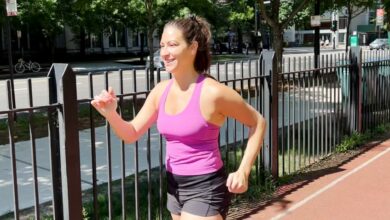“Me on a treadmill?” pondered Mrs. Wafaa, my 50-something landlady, after I described the machine to her. “Are you out of your mind? I can’t even walk upstairs!”
Mrs. Wafaa, whose primary vocation in life seems to be raising my rent, shares the same views on physical fitness as most of her generation. As we advance in years, we begin losing interest in physical activities–such as sports and long walks–in favor of more important hobbies, like watching Arabic-dubbed Turkish soap-operas and gossiping on the phone.
An active lifestyle, however, at any age, remains a core element of maintaining one’s health. Seniors can enjoy an illness-free, activity-filled life if they manage to keep physically fit.
Egyptian fitness expert Karim Strougo points to a new study that has introduced the notion of “biological age.” According to this concept, specialists can measure the age of the human heart and other organs to determine one’s “biological”–as opposed to one’s “chronological”–age.
“I see myself as 62 years young,” says Hania, a health enthusiast who takes fitness classes at least four times a week. “I first began training in my early 30s. I believe my addiction to exercise is what makes me an ‘oldie but goldie’.”
“Senior citizens should never stop exercising,” says Strougo. “Exercise can ensure that they have a lower biological age than their actual, chronological age.”
People beyond a certain age, however, should not begin exercising right away if they are not used to an active lifestyle, and should first get clearance from their doctors before hitting the gym or the fitness studio.
“Starting with a knowledgeable personal trainer is advisable for senior citizens,” Strougo stresses. “A good personal trainer will be able to create a ‘progressive’ overload, which will improve their fitness without exposing them to the risk of injury or health complications.”
The trainer should start to build the trainee’s fitness gradually to ensure that the latter is not jeopardized by unforeseeable elements. Basic yoga, therefore, is often advisable for newcomers. Yoga doesn’t have to involve extreme stretching to a background of fake Chinese music and a trainer that tells you to imagine yourself as a tree. On the contrary, yoga training can help eliminate the risks associated with over-stretching and Osteoporosis.
High-impact activities, however–such as jumping, tracking and weight-lifting–can be risky beyond a certain age. To determine whether a senior citizen is able to engage in these types of exercises, trainer and trainee should first have an honest conversation about the latter’s physical capabilities.
We, as personal trainers and fitness instructors, cannot stress enough the need for honest health-related answers from trainees, regardless of their age or gender. Health forms and lifestyle assessments represent our only way to avoid potential risks. Honesty with your personal trainer can help you sidestep a number of potentially unpleasant–or downright dangerous–surprises while working out.
Aside from the usual benefits of exercising, there is also a social and psychological element to working out.
“Sometimes, as we age, our muscles and bones become weaker,” Strougo says. “At some point, we may lose the ability to walk freely and have to depend on others to perform everyday activities. Exercise can help senior citizens maintain their autonomy for as long as possible.”




